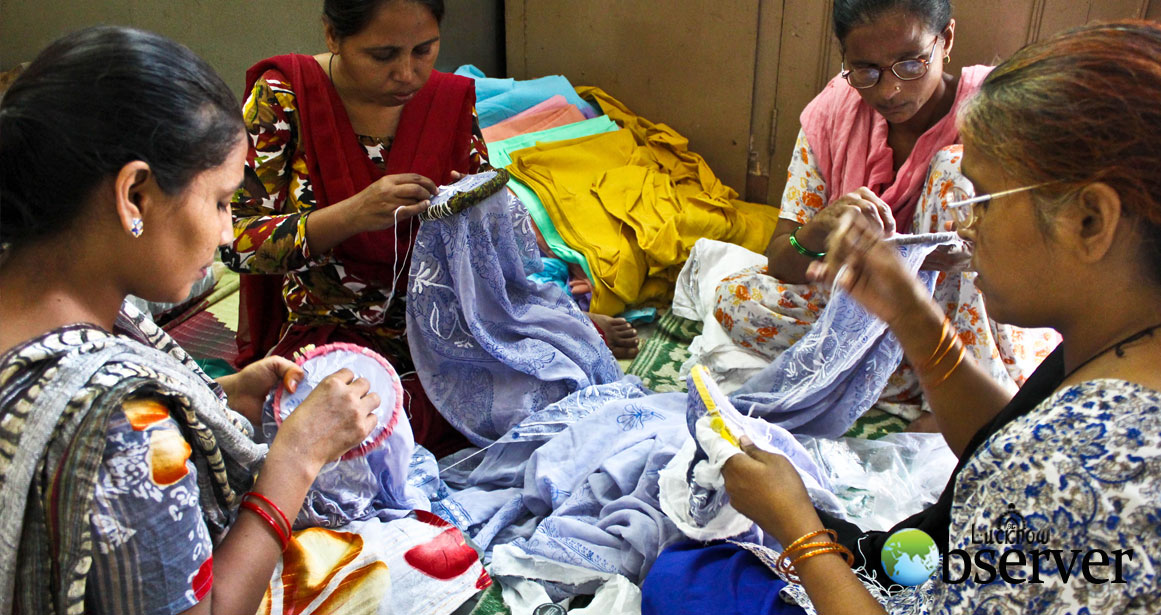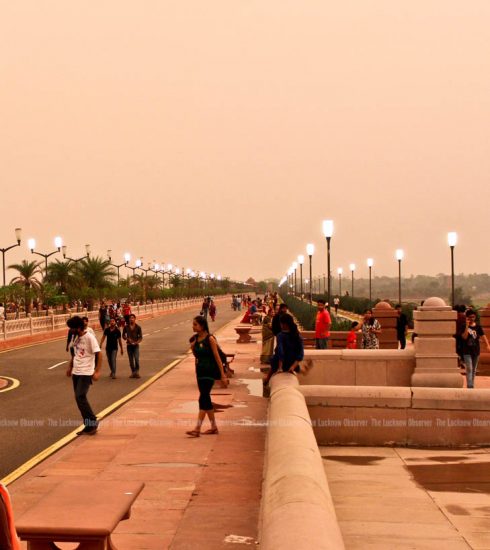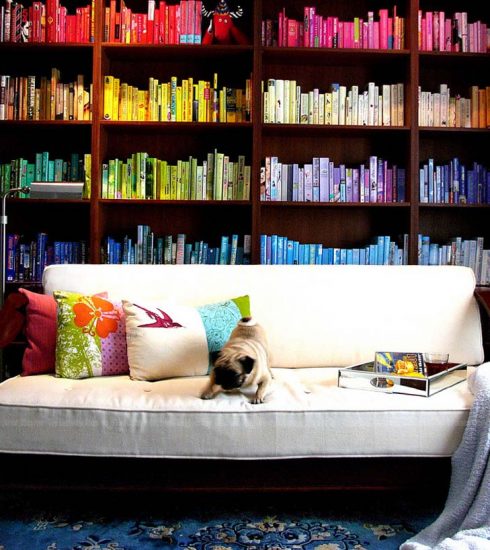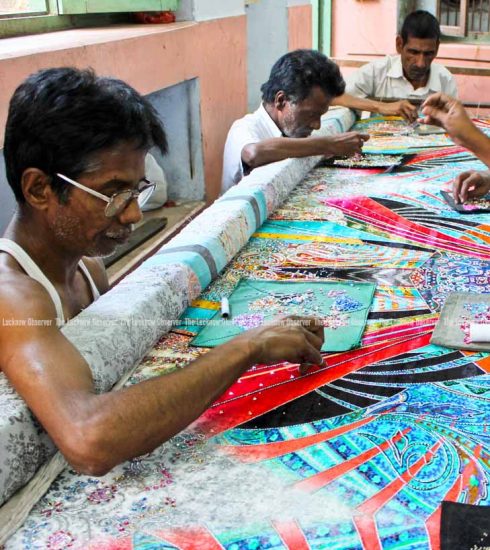Chikankari
Timeless, Classic – That’s Chikan Embroidery of Lucknow!
The timeless beauty of chikan and its elegance traces its origin to Lucknow. The word ‘chikan’ has been derived from Persian word ‘chikin’ or ‘chikeen’, which means kind of embroidered fabric or in particular needlework on colourless muslin called ‘tanzeb’. The origin of chikankari has undergone numerous interpretations. It is believed that the chikankari broadly refers to the period of Nawabs. Sharar mentions in his book ‘Guzishta Lucknow’ that it was during Nasir- ud-Din Haidar’s time, a four-cornered headgear was invented. To make it look fashionable the panels of the cap were covered in thin muslin upon which kaamdani or gold and silver crescents and designs were stitched in different colours. Popularity of chikankari is also linked to the Mughal harems. Jahangir’s wife Noor Jehan was inspired by

Turkish embroidery, which led to the innovation of chikankari. The origin of Chikankari is initiated by the influence of intricate carving patterns of Mughal architecture during their period. The Chikan work in Lucknow is older than 200 years and later it is patronized by Nawabs. Since then it has evolved and attained its glory and perfection in Lucknow, the capital of Uttar Pradesh. It not only enjoyed patronization of the Mughals but also attained perfection as the exquisite needlework and handwork underwent further honing and refinement. Admired the world over today, the art has trickled into every section of fashion world and every part of India. Lucknow has sustained an unrivaled supremacy in producing the finest Chikan in India. Keen on preserving the originality and preventing it from suffering a dilution to the market forces, the torchbearers of the couture, the craftsmen based in Lucknow, are reluctant to alter it according to the needs of the organized fashion world and tinsel town. But lately- courtesy the exposure and thus ascendance in market demand that some of the big opulent commercial successes like Mughal- e-Azam, Pakeeza, Zubeida and many more have ensured–there is a new found accommodative and adaptive attitude to be found among the hitherto conservationist craftsmen. The change in attitude and a sense of professionalism among the younger generation of chikankari workers have made them an indispensable property in the fashion marts as well as preserving the culture in its own way without compromising with the cultural heritage. Chikankari has been the delicate and traditional embroidery practiced in Lucknow and its environs. Chikan is a unique craft involving delicate and artistic hand embroidery on a variety of textile fabrics like cotton, muslin, silk, chiffon, organdy, organza and doriya. The source of the most motifs in chikankari is Mughal. Though it originated as the court craft, today it is a practiced tradition and an important commercial activity. This living craft tradition has seen vicissitudes but remains rooted in the city of origin.
There are 5000 families involved in Chikankari embroidery in and around villages of Lucknow. The artisans belong to local Muslim community. Nearly women do 90% of Chikankari work professionally. Different specialists work with different types of stitches. For example, embroiderers who do the filling work do not do jali. Each worker completes his/her bit and the fabric is then sent to the next embroiderer. Thus, each handcrafted piece talks volumes about the number of people involved in making it and the long hours put in. Delhi, Mumbai are the other centers for Chikankari work.

Chikankari Artisans
Stitches of Chikankari:
The basic stitches are six in number and over 32 other traditional stiches used in combination.
- Tepchi is a long running or darning stitch worked with six strands on the right side of the fabric taken over four threads and picking up one. Thus, a line is formed. It is used principally as a basis for further stitchery and occasionally to form a simple shape.
- Bakhiya, double back or shadow stitch in chikan work is done from the wrong side of the fabric and the design is rendered in the herringbone style. The shadow of the thread is seen through the cloth on the right side.
- Hool is a fine detached eyelet stitch. Herein, a hole is punched in the fabric and the threads are teased apart. It is then held by small straight stitches all round and worked with one thread on the right side of the fabric. It can be worked with six threads and often forms the center of a flower.
- Zanzeera is a small chain stitch worked with one thread on the right side of the fabric. Being extremely fine, it is used to finally outline the leaf or petal shapes after one or more outlines have already been worked.
- Rahet is a stem stitch worked with six threads on the wrong side of the fabric. It forms a solid line of backstitch on the right side of the fabric and is rarely used in its simple form but is common in the double form of dohra Bakhiya as an outlining stitch.
- Banarsi stitch has no European equivalent and is a twisted stitch worked with six threads on the right side of the fabric. Working from the right across about five threads a small stitch is taken over about two threads vertically. The needle is reinserted halfway along and below the horizontal stitch formed and is taken out about two threads vertically on the right above the previous stitch.
- Khatau is similar to Bakhiya, but finer and is a form of applique. In Khatau, the design is prepared on calico material. That is placed over the surface of the final fabric and then paisley and floral patterns are stitched on to it.
- Phanda and Murri are the forms of stitches used to embroider the centre of the flowers in ordinary chikan work motifs. They are typically French knots, with murri being rice-shaped and phanda millet-shaped.
- Jali stitch is the one where the thread is never drawn through the fabric, ensuring that the back portion of the garment looks as impeccable as the front. The warp and weft threads are carefully drawn apart and minute buttonhole stitches are inserted into the cloth.
- Turpai and Darzdari are also significant stitches in chikan work. Turpai should have an effect of a thin thread. Darzdari have several varieties, the popular ones are Kohidarz, Kamal darz, Shankarpara darz, Muchii and Singbhada darz.
- The various other types of legendary chikankari stitches are: Pechani, Bijli, Ghaspatti, Makra, Kauri, Hathkadi, Banjkali, Sazi, Karan, Kapkapi, Madrazi, Bulbul- chasm, Taj Mahal, Zanzeera, Kangan, Dhania-patti, Rozan, Meharki, Chanapatti, Baalda, Jora, Keel Kangan, bulbul, sidhaul, ghas ki patti etc. Drifting apart from the original pristine setting, the tone-on-tone embroidery is in vogue these days. The significant use of beads, sequin and mukaish (white flat silver strip embroidery) have gained wide acceptance.
In 2008 the Lucknawi chikan was accorded the Geographical Indication (GI) under the Geographical Indication Registry (GIR), recognizing Lucknow as the exclusive hub for chikankari. There have been constant efforts by the karigars to include newer designs in chikankari and keep the art alive. Whether moderately priced or exorbitantly, chikan work is an all time classic. One can wear it on all occasions be it formal or informal. It is an undeniable fact that Lucknow exhibits India’s finest chikan embroidery, spreading glory all around!
Akansha
Writer is a student, an aspiring painter & calligrapher
(Published in The Lucknow Observer, Volume 1 Issue 12, Dated 05 March 2015)









